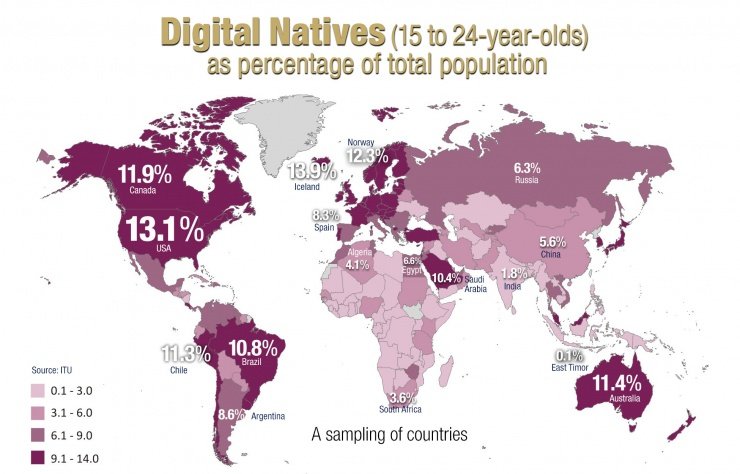On-demand marketing is on its way at fast speed. As our daily lives, due to the mobile devices, are becoming more and more permanently embedded on digital environments, digital marketing faces new challenges, as it needs to become both more relevant and responsive. If on-demand marketing will be an unavoidable fact on a near future, it is important to be aware that it is actually already here, shaping our life experiences. It is now already possible, for example, to go to a restaurant and look up on Google Now for recommendations on the menu. Before you leave, you can check how the traffic is like and choose the best way to go back home. You can also use one app that lets you know where to stop for ice cream, and another one to know what the weather is like. All of your questions are answered in real-time. This is on-demand marketing.
But as digital capabilities become more enhanced, consumer demands will rise. People now want to be able to interact anytime, anywhere, and in a wasy way, and they expect that their experience is truly customized to their own likes and interests. Essentially, each user experience on the Internet will be unique while maintaining consistency across platforms.
According to an article published by Agency McKinsey, written by Peter Dahlström and David Edelman, the big challenges that will transform marketing, are due to two factors:
- The technological evolutions
- The consumer expectations.
As you may know, technology already makes product information to be ubiquitous. On the other hand, social media platforms enable consumers to share, compare, and rate their experiences. And as more innovations are on its way, on-demand marketing will be further shaped to fit those transformations. Some of such innovations are mobile connectivity, that is enabling better-designed online spaces created with the new HTML5 Web language, the growing activation of the Internet of Things in many devices, and more skillful handling of “big data.”According to the report: “Consumers may soon be able to search by image, voice, and gesture; automatically participate with others by taking pictures or making transactions; and discover new opportunities with devices that augment reality in their field of vision (think Google glasses)”.
The article previews consumer demands to rise in four areas:
- Now: Consumers will want to interact anywhere at any time.
- Can I: They will try to do new things as disparate kinds of information (from financial accounts to data on physical activity) are deployed more effectively in ways that will serve their needs.
- For me: They will expect all data stored about them to be targeted precisely to their needs or used to personalize what they experience.
- Simplicity: The interactions should be easy.
As interactions multiply, companies will want to use techniques to shape consumer experiences. Those techniques might be:
- The use of design thinking, which stands for design-specific cognitive activities that designers apply during the process of designing.This concerns the ability to combine empathy for the context of a problem, creativity in the generation of insights and solutions, and rationality to analyze and fit solutions to the context.
- A familiarization with emerging tools for gathering the right data across the consumer decision journey.
- A better integration and collaboration between the various functions and businesses.
The near future of 2020
McKinsley produced an infographic, that facilitates our understanding of what the near future reserves for marketing. The infographic follows Diane, who purchases an audio headset in 2020.
McKinsey GlobalDiane´s experience, displayed in the above infographic, is possible due to various technologies, particularly the near-field communication (NFC): embedded chips in phones exchange data on contact with objects that have NFC tags. NFCs are now so cheap that soon any company can build them into almost any device. It will be then possible to have a massive and continuous interactive experience.
McKinsey´s article examines the various scenes from Diane’s journey as a way to illustrate the four emerging areas of consumer demands:
Now
Marketers are predicting that consumers will have desire for more urgency and ubiquity. They write: “Digital information technologies, operating behind the scenes to integrate data on all interactions a consumer has across the decision journey, will provide insights into the best influence pathways for companies, while also triggering new personalized experiences for consumers.”
Can I
New things and experiences will be now possible due to novel programming, data-access, and interface possibilities. The public in general can be offered something exceptional which is now possible by enhanced technological capability in integrating disparate sources of information, at low cost and at scale, for many new domains. The example given by McKinsey is the Commonwealth Bank of Australia’s new smartphone app, that aims to change the house-buying experience:
“A prospective home buyer begins by taking a picture of a house he or she likes. Using image-recognition software and location-based technologies, the app identifies the house and provides the list price, taxes, and other information. It then connects with the buyer’s personal financial data and (with further links to lender databases) determines whether the buyer can be preapproved for a mortgage (and, if so, in what amount). This nearly instantaneous series of interactions cuts through the hassle of searching real-estate agents’ sites for houses and then connecting with the agents or with mortgage brokers for financing, which might take a week.”
Commonwealth Bank of Australia Property Guide AppFor Me
Mass customization is a major trend happening right now and that will imply changes to online marketing as there will be more demand for personalized experiences . The report mentions how Facebook will eventually be able to mine the world’s largest database of photographs, linking individual people to their activities. One should be aware that our smartphones, that we use to take pictures and engage in various kinds of activities, are now loaded with data about every place where you have traveled to.Threats to privacy, security, and general trust are as such, the hot issues of the day
McKinsey´s stance on the issue of privacy is quite optimist: They refer that if companies use the captured information to provide truly helpful feedback, or as a way to offer recommendations, services, and customization tools , consumers will be impelled to provide more data.
Simplicity
The consumer will increasingly demand simplicity. An example is Starbucks tap-and-go app that enables mobile payments. Yet many interactions remain complex and fragmented.
Starbucks tap-and-go app enables fast paymentsSetting strategies and building capabilities
The report finishes by giving advice to companies on how to address marketing on demand, highlighting how it is important to make data and discovery a nonstop cycle. The process of making data and discovery should be tackled by using three distinct data lenses:
Telescope
A clear view of the broad trends in your market, category, and brand is essential. Digital sources that track what people are looking for (search), what people are saying (social monitoring), and what people are doing (tracking online, mobile, and in-store activities) represent rivers of input providing constant warning signs of trouble or signals of latent opportunity.
Binoculars
Companies will need to push every customer-facing function to work together and form an integrated view of consumer decision journeys. With longitudinal pictures of customers’ touches and their outcomes, companies can model total costs per action, find the most effective decision-journey patterns, and spot points of leakage. As more contacts become digitized—and they will—the data will gradually get easier to create.
Microscope
Trust is essential, and personalization can show customers they matter. Consumers will increasingly expect a brand to be using wisely the data companies own about them.
The report concludes that companies are in need for more people who can improve a company’s approach to social media, big data, and the customer experience. It seems crucial that companies should stay ahead of the design, data, and delivery requirements of on-demand customers. If on-demand Marketing seems so appealing and filled with opportunities for companies, the big question mark is if consumers will be willing to share their consumer experiences online with their friends and whether they will react to on-demand marketing as being extremely intrusive. If we already live permanently embedded in a digital world due to the mobile devices, to have the experience of being ubiquitously messaged with on-demand marketing suggestions, might be a turn off to consumers.
The full article can be accessed at:
The coming era of on-demand marketing

Maria Fonseca is the Editor and Infographic Artist for IntelligentHQ. She is also a thought leader writing about social innovation, sharing economy, social business, and the commons. Aside her work for IntelligentHQ, Maria Fonseca is a visual artist and filmmaker that has exhibited widely in international events such as Manifesta 5, Sao Paulo Biennial, Photo Espana, Moderna Museet in Stockholm, Joshibi University and many others. She concluded her PhD on essayistic filmmaking , taken at University of Westminster in London and is preparing her post doc that will explore the links between creativity and the sharing economy.





























